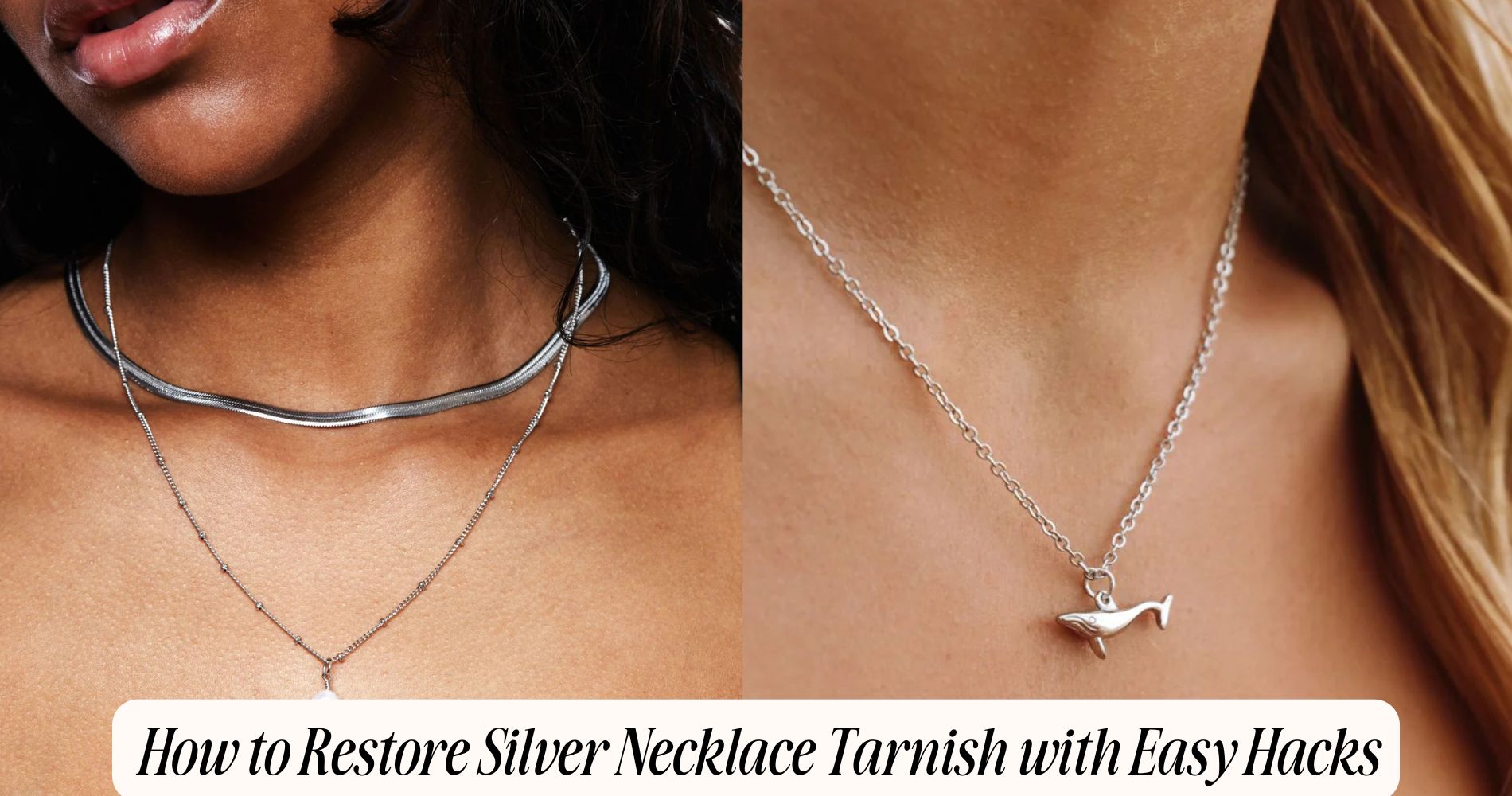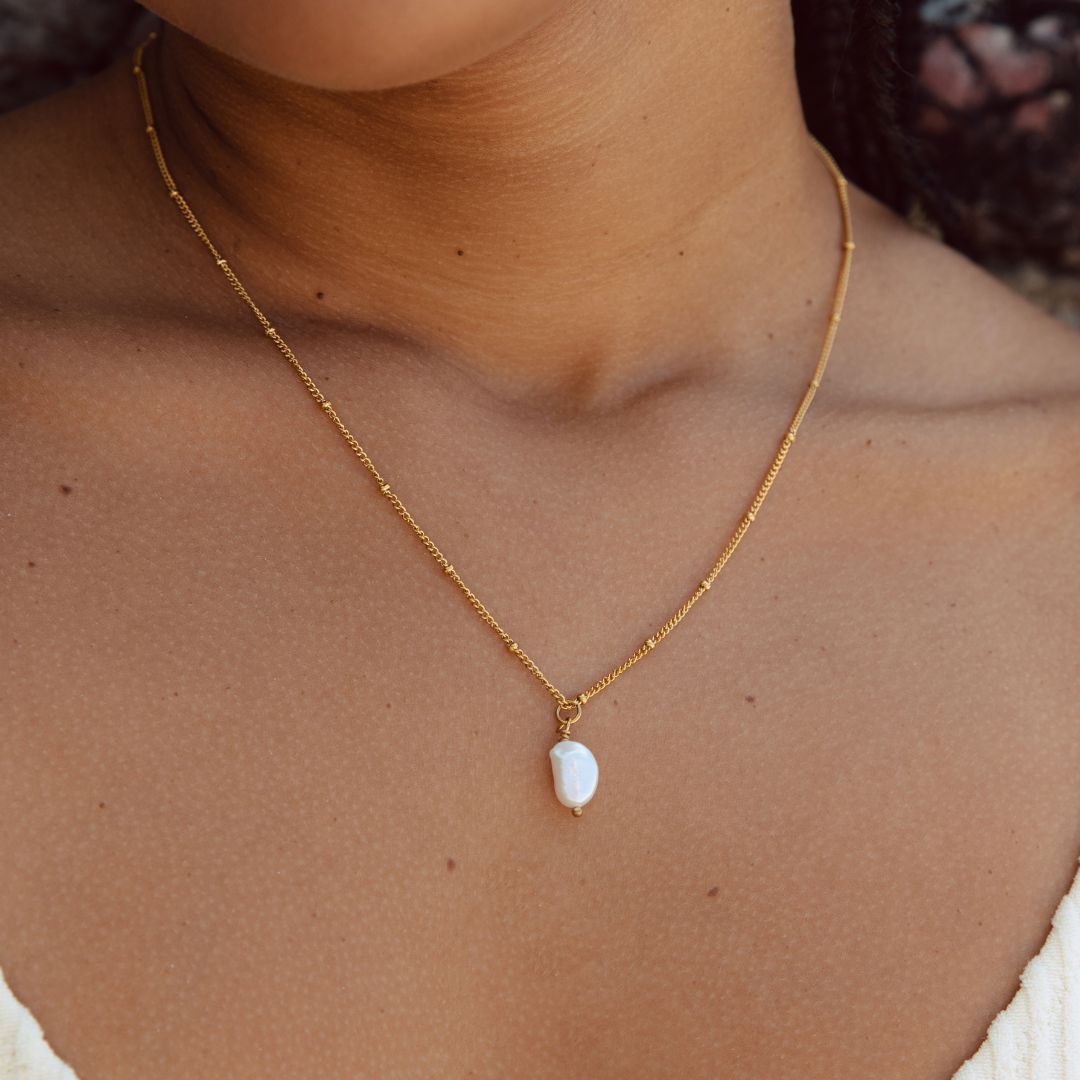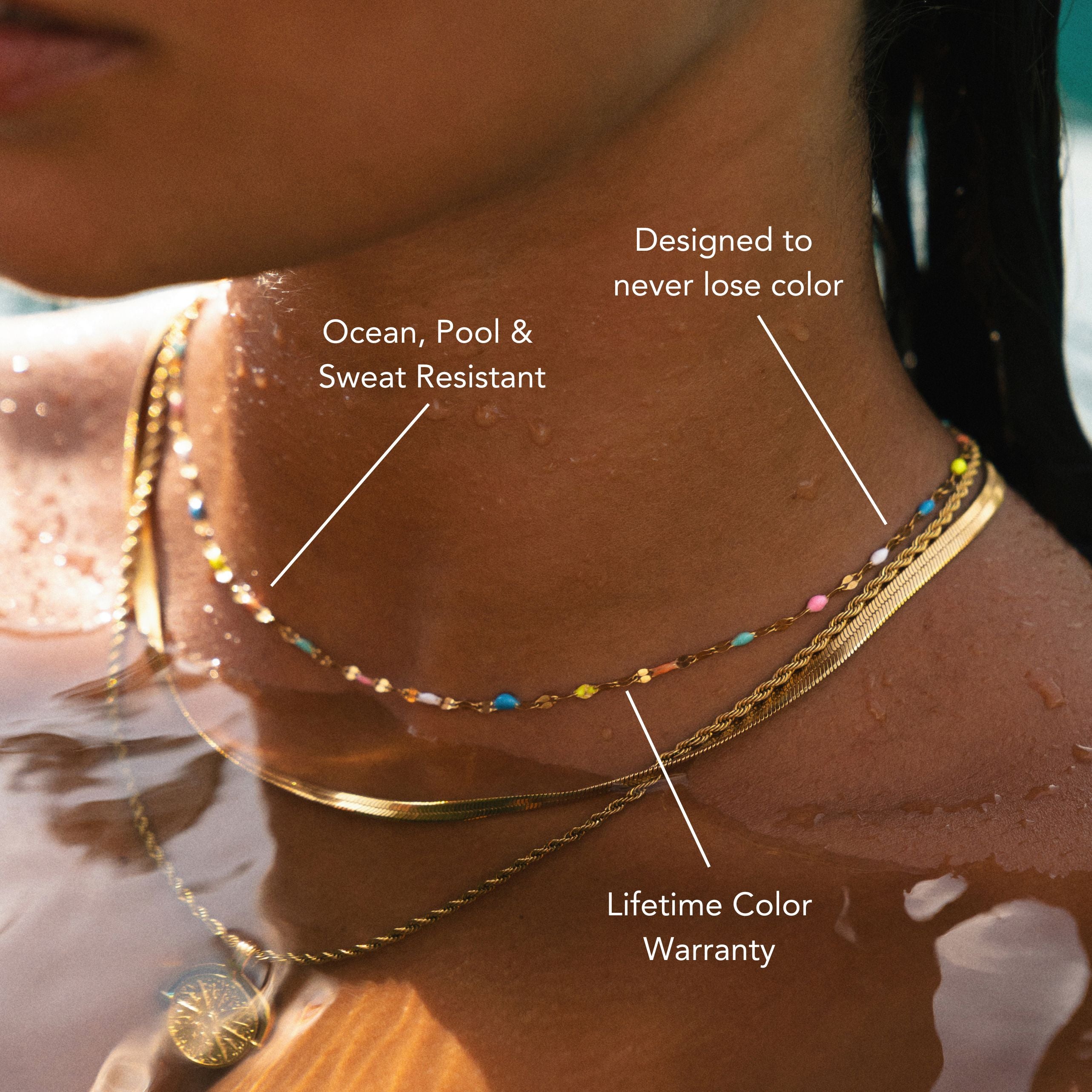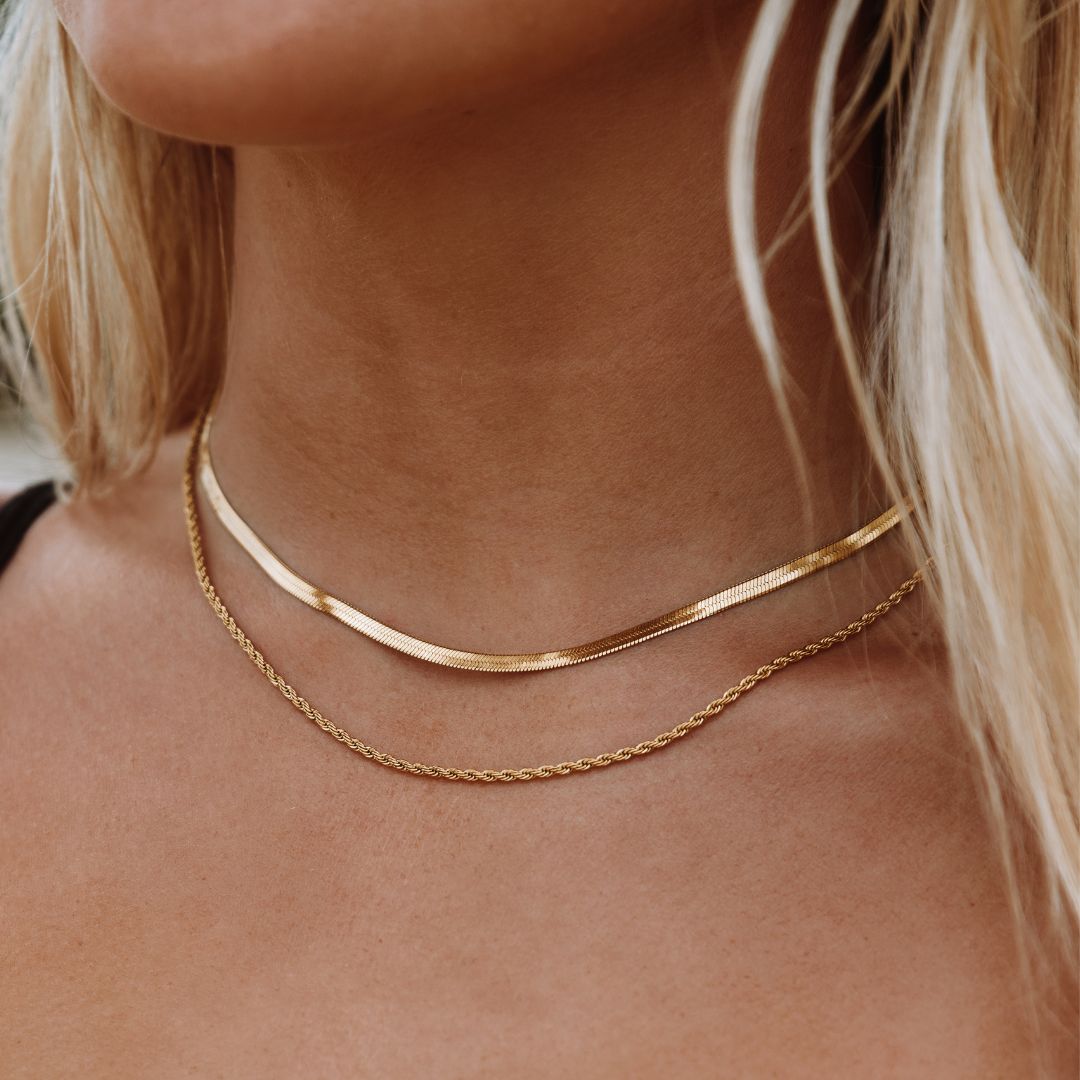
How to Restore Silver Necklace Tarnish With Easy Hacks
Learning how to restore silver necklace tarnish is easier than you might think, especially with a few common household items. Start by mixing two tablespoons of baking soda with a bit of water to create a paste. Gently rub this onto the tarnished areas, then rinse and dry thoroughly. Another effective method is to line a bowl with aluminum foil, fill it with hot water and salt, and let your necklace soak for 5-10 minutes before rinsing. Non-gel toothpaste also works well—simply scrub gently with a soft toothbrush, rinse, and dry. To maintain its shine, store your necklace properly and control moisture levels. If you're interested in more stylish options, explore our cute silver necklaces for pieces that stay beautiful with simple care. There's so much more to discover!
Understanding Silver Tarnish
Many people don't realize that silver tarnish is a natural process caused by a reaction between silver and sulfur compounds in the air or from skin contact. This reaction forms silver sulfide, which appears as a dull or dark layer on your jewelry. Understanding tarnish causes is essential for effective silver care.
Factors like humidity, temperature, and exposure to certain chemicals can accelerate tarnishing. For instance, wearing your silver necklace while applying lotions or perfumes can lead to quicker tarnish formation.
Additionally, storing silver in airtight containers can help slow down this process by limiting exposure to air and humidity.
To keep your silver necklace looking its best, regular maintenance is key. Consider wearing your jewelry frequently, as the natural oils from your skin can help reduce tarnish buildup.
When you're not wearing it, store your silver pieces in a cool, dry place, preferably with anti-tarnish pouches or cloths.
Basic Cleaning Supplies Needed
To effectively restore your tarnished silver necklace, you'll need a few essential cleaning materials at hand.
Consider using items like baking soda, vinegar, and a soft cloth for homemade cleaning solutions that are both safe and effective.
Gathering these supplies will set you up for successful tarnish removal.
Essential Cleaning Materials
Restoring tarnished silver jewelry requires just a few essential cleaning materials that you likely already have at home. First, grab some soft cleaning cloths. Microfiber cloths work great because they won't scratch the silver's surface and help lift dirt and tarnish effectively.
You'll also want to have some polishing tools on hand. These can be specialized silver polishing cloths or non-abrasive sponges, which are perfect for gently buffing your necklace back to its original shine.
Additionally, a small bowl can be helpful for rinsing your jewelry after cleaning. If you have a soft-bristled toothbrush, it can assist in getting into any intricate designs on your necklace. Avoid using rough materials, as they can create scratches.
Having a dedicated space for your cleaning process is also beneficial. Lay down a clean towel to catch any debris.
With these essential cleaning materials, you'll be ready to tackle tarnish and restore your silver necklace's beauty. Once you gather everything, you'll be well-prepared to plunge into the cleaning process and bring your jewelry back to life.
Homemade Cleaning Solutions
If you're looking to bring your silver necklace back to life, homemade cleaning solutions can be both effective and economical. You don't need expensive products; instead, consider using simple ingredients that you likely already have at home.
Start with baking soda, a great natural cleaner that can easily tackle tarnish. Mix three parts baking soda with one part water to form a paste. Apply it gently with a soft cloth, then rinse the necklace with warm water and dry it thoroughly.
Another option is to use white vinegar and baking soda. Combine half a cup of vinegar with two tablespoons of baking soda in a bowl. Soak your necklace in this mixture for about two to three hours, and then rinse it under cool water.
For an eco-friendly solution, lemon juice works wonders too. Just mix equal parts of lemon juice and water. Soak your silver jewelry for a few minutes, then rinse and dry.
These homemade cleaning solutions aren't only effective, but they also help you maintain a sustainable approach to caring for your jewelry. Enjoy your sparkling silver necklace!
Baking Soda and Water Method
Using a simple combination of baking soda and water, you can effectively tackle tarnish on your silver necklace. This method is one of the most accessible silver cleaning techniques and highlights the baking soda benefits, making it a go-to choice for many jewelry enthusiasts.
To start, mix two tablespoons of baking soda with a small amount of water to create a paste. The consistency should be thick enough to stick to your necklace.
Apply the paste directly to the tarnished areas, using a soft cloth or your fingers. Gently rub the paste into the silver in circular motions. The baking soda acts as a mild abrasive, helping to lift tarnish without scratching the surface.
After you've treated the entire tarnished area, rinse your necklace thoroughly under lukewarm water to remove any residue. Pat it dry with a clean, soft cloth.
You'll notice how the baking soda not only cleans but also restores the shine of your silver. This method is quick, economical, and safe, making it a practical choice for maintaining the beauty of your silver jewelry.
Aluminum Foil and Salt Technique
One effective method for removing tarnish from your silver necklace involves the combination of aluminum foil and salt. This tarnish removal technique is simple and requires just a few household items.
Start by lining a bowl with aluminum foil, shiny side up. Then, fill the bowl with hot water and add a tablespoon of salt. Stir the mixture until the salt dissolves completely.
Next, place your tarnished silver necklace in the bowl, ensuring it's in contact with the aluminum foil. The chemical reaction between the salt, aluminum, and tarnish will effectively lift the tarnish from your necklace. Let it sit for about 5 to 10 minutes, occasionally checking the progress. If the tarnish persists, you can gently rub the necklace with a soft cloth while it's submerged.
After the tarnish is gone, carefully remove the necklace and rinse it under cool water to wash away any residue. Dry it thoroughly with a soft, lint-free cloth.
This cleaning technique not only restores your necklace's shine but also helps prevent future tarnishing. With this easy method, you'll keep your silver jewelry looking beautiful and bright!
Using Toothpaste for Restoration
Toothpaste can serve as a surprisingly effective solution for restoring the shine of your tarnished silver necklace. The mild abrasives in toothpaste help remove tarnish without scratching the silver, making it a popular choice for silver restoration.
To start, gather your materials: a soft toothbrush, a small bowl, and a non-gel toothpaste. Avoid whitening or abrasive formulas, as these can damage your jewelry.
Squeeze a small amount of toothpaste into the bowl and dip the toothbrush into it. Gently scrub your necklace with the toothbrush, focusing on tarnished areas. Use circular motions to lift away the tarnish effectively.
After a few minutes, rinse the necklace under lukewarm water to wash away the toothpaste residue. Make sure you thoroughly rinse it, as leftover toothpaste can dull the shine.
Finally, dry your necklace with a soft, lint-free cloth to reveal the restored brilliance.
Using toothpaste benefits not just your silver jewelry but also offers a quick and accessible cleaning method. This simple technique can breathe new life into your tarnished silver necklace, showcasing its beauty once again.
Preventing Future Tarnish
To keep your silver necklace looking its best, you need to store it properly and avoid moisture exposure.
Use a soft cloth to wrap your necklace and place it in a cool, dry place to minimize tarnish.
Additionally, steer clear of wearing it in humid environments, like the bathroom, to further protect against tarnishing.
Store Properly
Storing your silver necklace properly is vital for preventing future tarnish. Start by choosing a suitable jewelry box designed specifically for silver items, as these often have anti-tarnish properties.
Look for boxes lined with soft fabric that won't scratch your jewelry, while also providing a protective barrier against air exposure.
When placing your necklace in the jewelry box, consider keeping it in a separate compartment or a soft pouch. This minimizes contact with other pieces, which can lead to scratching and increased tarnish.
Confirm that the box is kept in a cool, dry place, away from sunlight and heat sources that may accelerate tarnishing.
Avoid using plastic bags for long-term storage, as they can trap moisture and lead to tarnish. Instead, opt for breathable fabric pouches or acid-free tissue paper.
You can also add anti-tarnish strips to your jewelry box for extra protection. Regularly check your storage area to confirm it remains clean and free of humidity.
Avoid Moisture Exposure
Moisture is one of the primary culprits behind silver tarnish, so keeping your necklace dry is essential. To prevent tarnishing, you should focus on humidity control in your storage environment. Aim for a humidity level below 50%, as higher humidity can accelerate tarnish formation.
Consider using a dehumidifier in your jewelry storage area, especially in humid climates.
Additionally, you can create moisture barriers for your silver necklace. Store it in an airtight container or a zip-lock bag to limit exposure to air and moisture.
Placing anti-tarnish strips or silica gel packets in the storage container can absorb excess moisture, further protecting your jewelry.
When wearing your necklace, try to avoid environments where moisture can accumulate, like pools, spas, or even during heavy workouts.
It's wise to remove your necklace before showering or washing your hands to minimize moisture contact.
Frequently Asked Questions
Can I Use Dish Soap for Cleaning Tarnished Silver?
Yes, you can use dish soap for cleaning tarnished silver. Its effectiveness lies in breaking down grime. However, consider silver cleaning alternatives like baking soda or vinegar for deeper tarnish removal and safer long-term care.
How Often Should I Clean My Silver Necklace?
You should clean your silver necklace every few weeks to maintain its shine and prevent tarnish buildup. Regular cleaning frequency helps preserve its beauty, so follow these maintenance tips for ideal care and longevity.
Is Tarnish Harmful to My Silver Jewelry?
Tarnish isn't harmful to your silver jewelry, but it can dull its shine. Regular tarnish removal and proper silver preservation techniques can keep your pieces looking vibrant and protect them from potential damage over time.
Can I Use These Methods on All Silver Types?
You can use these methods on most silver types, but always check each piece's specific care needs. For best results, follow tarnish prevention tips and consider silver storage solutions to maintain your jewelry's shine.
What Should I Do if Tarnish Persists After Cleaning?
If tarnish persists after cleaning, try additional cleaning methods like a silver polish or ultrasonic cleaner. For preventive care, store your necklace in a dry, airtight container to minimize future tarnishing and maintain its shine.
Conclusion
Restoring your silver necklace from tarnish doesn't have to be a hassle. With simple methods like baking soda, aluminum foil, or even toothpaste, you can bring back its shine in no time. Remember, prevention is key—store your jewelry properly and clean it regularly to keep tarnish at bay. By following these easy hacks, you'll guarantee your silver pieces stay beautiful and vibrant for years to come. Enjoy wearing your revitalized jewelry with confidence!























Leave a comment
This site is protected by hCaptcha and the hCaptcha Privacy Policy and Terms of Service apply.